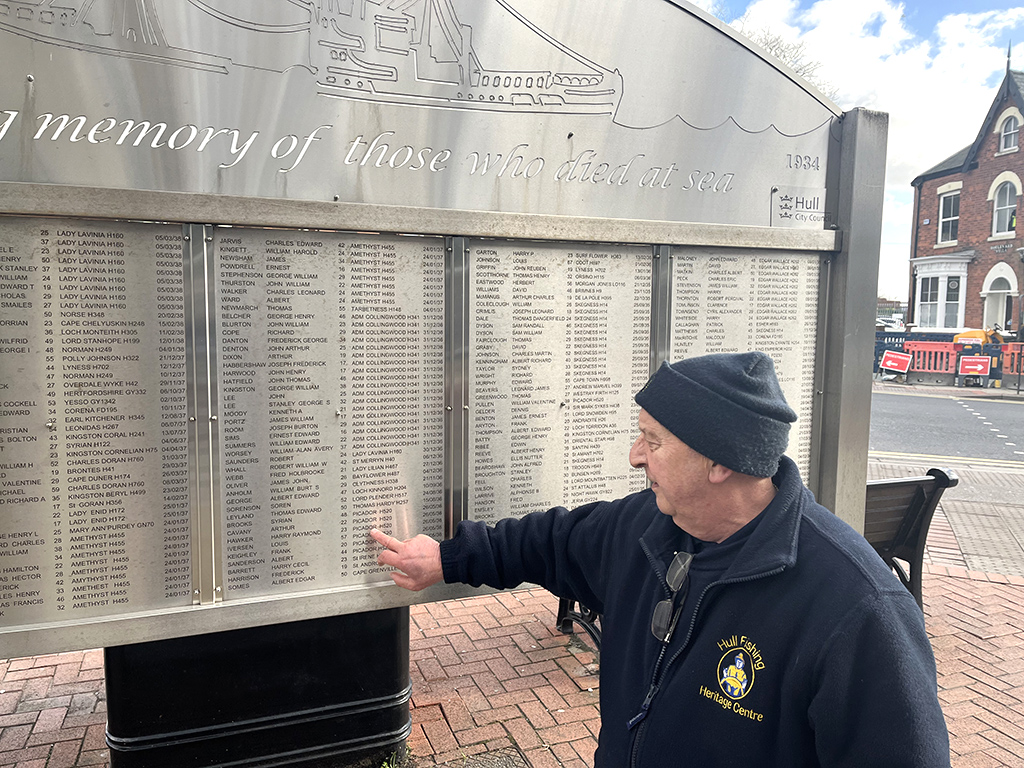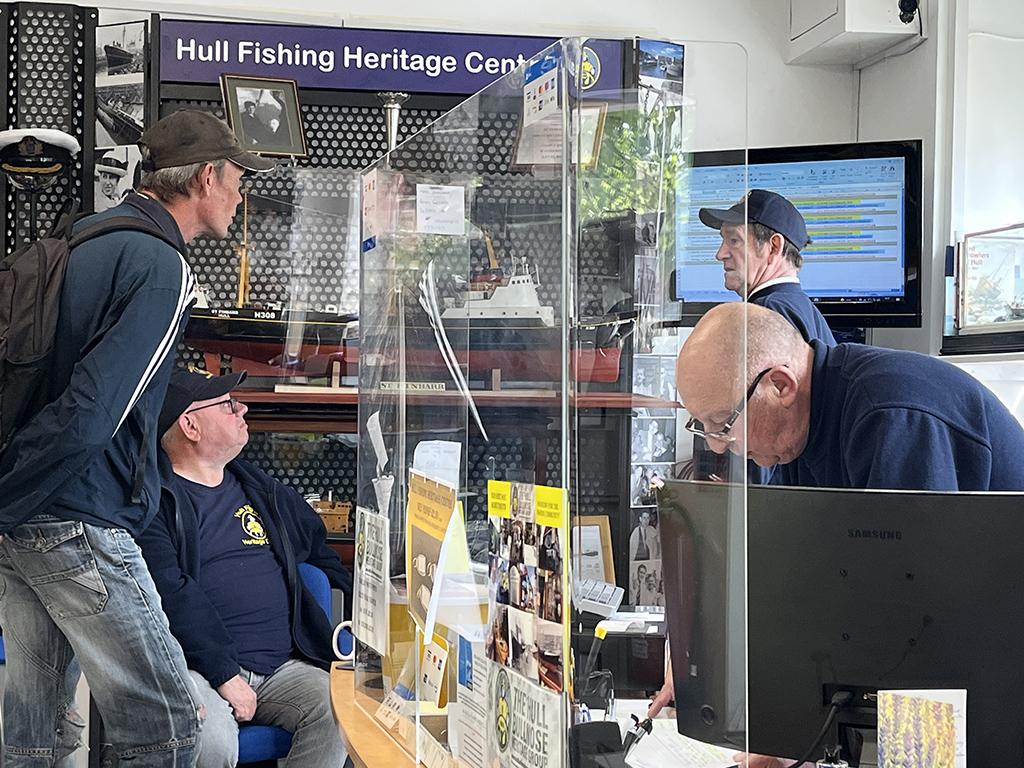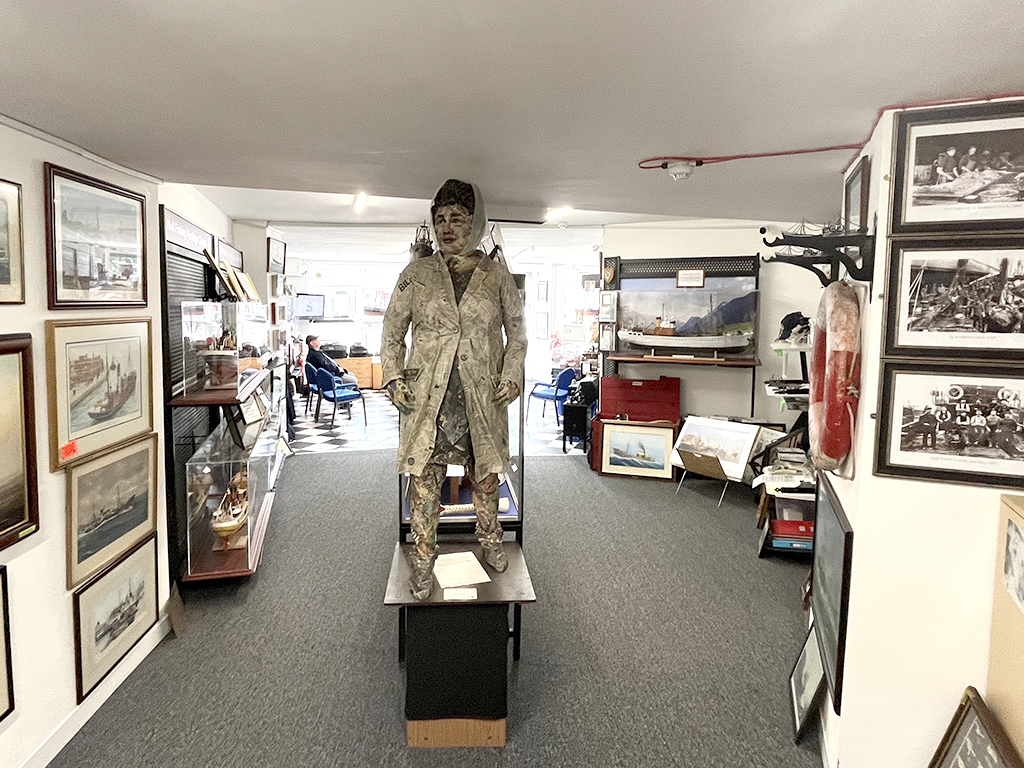
Brian W Lavery visits a Hornsea retired trawler skipper and friends who have taken fishing’s history and heritage into their own hands
A few years ago it looked like just another long city thoroughfare with little or nothing really to show it was once home to the greatest deep sea fishery in the world.
Today Hessle Road has an illustrated – and illustrious – history told in murals alongside new memorials, civic furniture, public art and a museum run by ex-fishermen at its heart.
On the gable wall of the Half Way pub – still a regular haunt for fishermen – is giant artwork of a yellow-waterproof-and-sou’wester-clad trawlerman mending a net.
Opposite, another depicts a “terrace-ender” – an old Hessle Road phrase for fishwives gossiping on street corner.
You can almost hear the chit-chat from the figures emblazoned across a 20ft high “canvas” – a long wall housing a triptych of Hessle Road imagery from times gone by.
It shows women mending nets and pushing tank-like baby carriages amid a collage of fi shing imagery.
“Terrace-ender” was a phrase that became general parlance for gossip and one that skippers would use to reprimand any deckhands slacking or chatting when they should have been at work.
“Hey… less of the terrace-enders and a bit more work,” would be a regular rebuke, according to former skipper and heritage campaigner Ray Hawker, whom I am on my way to meet further along what locals simply call “Road” – not “the road”, or “Hessle Road” – just “Road”.
Although the industry is all but gone, “Road” still booms. Pubs and shops along its four miles are busy every day – and buzzing on a Saturday.
Ex-fi shing folk still live there too – and those who left to live in the “new estates” of the 1960s and 1970s come back and visit – like children popping in to check on an aged relative.
Further along at the junction with Boulevard – there is a crossroads.

Here, flags in the trawler companies’ livery stand high above the pavement, in honour of famous ships gone – never to return. The funnel-like flags honour the men of the 1960’s Triple Trawler Disaster and those who perished in the Gaul in early 1974.
They stand as sentinels over re-creations of the old “bethel boards” that once recorded the names – men who left this great port never to return.
In the past, bethel boards were housed in churches. The names of lost trawlermen would be painted in gold leaf on these large varnished panels – after all, there are no graves for those who perished.
But not all who were lost had their names on the bethel boards, for, as Ray was to explain later: “Some folk could not afford the gold leaf paint.”
This was one of the drivers for the ex-trawlermen who have given the new bethel boards pride of place in the centre of the community.
These large shiny silver memorials are surrounded by benches in honour of the four women – Lillian Bilocca, Mary Denness, Yvonne Blenkinsop and Christine Jensen – later known as the Headscarf Revolutionaries – who successfully campaigned for better trawler safety after the St Romanus, Kingston Peridot and Ross Cleveland perished with the loss of 58 men in 1968.
There is also a mural of the campaigning women – the last of whom, Yvonne Blenkinsop, passed away earlier this year.
Further along and large black plant pots ablaze with colour are dotted around the pavement outside of the building at centre of this heritage and art boom – the Hull Fishing Heritage Centre, a museum and archive staff ed entirely by ex-trawlermen – all of whom are volunteers.
And it was they who commissioned local artists Andy Pea, Sharon Darley and Lydia Caprani to create the murals, funded by the city council and the organisation set up in 2015 to mark Hull’s year as culture city two years later.
It is here that I met up with Hornsea-based retired trawler skipper Ray and others from the Hull Bullnose Heritage Group (HBHG), which runs the museum.
These men, from across East and North Yorkshire, love the history that they have brought back to the place of its origin – and their enthusiasm in promoting that heritage is matched by their lived experience.
When I arrive, Ray is with HBHG chairman Jerry Thompson and committee member Gary Walsh.
It not long after 9am and the museum has been open only a few minutes.
There is always something to do – records to be updated, exhibits to be kept tidy, requests for information to be answered – and of course visitors to be informed.
There is a tall, slim man in his mid-40s talking with Jerry who is showing him a newspaper cutting on a computer screen perched on a wall bracket.
I find out the tall man is called Geoff Broxham. Jerry is reading to him from the old cutting.
He clicked on a file called “lost list” – it bring ups names, records and cuttings to the screen’s desktop.
This cutting tells of a frantic woman who has “not eaten nor slept for days” […] “all I do is wander about…”she tells a reporter.
The report goes on tell of her anguish and fear about impending widowhood. Her two children are with her, the old Hull Daily Mail story says.
It adds the kids are 13 and 10 respectively.
“My mam was the 13-year-old,” Jerry tells a rapt Geoff.
It transpires that Jerry’s grandfather Thomas Wilson was lost at sea. I wonder what Geoff the visitor makes of it all.
“I am not a visitor. I going to volunteer here,” 45-year-old Geoff told me.
He has recently returned to Hull and he still works as a fisherman – having his own crab boat out of Whitby.
He added: “I got a flat nearby after returning to Hull from Ireland where I was working. I have my own boat and still work fishing.
“I have popped in a few times. It’s a fascinating place.
“I thought this place was run by the council – or the museum service or similar – but I found out it is all done by these guys, so I want to join.”
The HBHG has a massive archive of photos, newspaper cuttings, fishermen’s records from Trinity House – and a growing digitised store of the names of men long gone.
One of the services the HBHG offers free is to trace relatives’ history and records on behalf of curious families.
Their website houses a trove of information to rival any university and it is open to academics, researchers, families and random visitors alike.
“We have tears in here many a time,” says Jerry. “Often I have found perhaps the only photo they will have of a relative gone by. That is why it is vital we keep this heritage alive.”
It is a Monday morning and Jerry has spent his weekend scanning and digitising thousands of images of Hull trawlers from an archive he bought – from his own pocket – from a local collector.
There are 8,000 images in all for Jerry to add to the museum’s amazing records.
Jerry added: “I have more than 130,000 photos from across the century and have gone through millions of newspaper pages over the decades. I also have an extensive record of every trawler to have sailed from this port – many never to have returned.”
As shown by the cutting on the screen, these records are very real and affecting indeed.
Earlier, while being shown the bethel boards outside, Jerry pointed me to his grandfather’s name – Thomas Wilson – and Ray pointed to his namesake – Harry Raymond Hawker, his father’s brother.
His uncle was known as Ray – and he was one of six men who died when on the trawler Picador in 1936.
While Ray told about his uncle’s fate he pointed to another name – it was one that had not been on the original bethel boards.
For Arthur Cavany’s family could not afford the gold leaf tribute.
Ray is happy that now there is this memorial for Arthur now – and many others that HBHG uncover in research.
“Arthur’s great-great nephew married my daughter,” Ray adds with a smile that enhances just how close this place is to its people.
While gathering details of the men lost to the sea, Jerry has come up with some interesting but sad statistics for the city.
“Walcott Street has the biggest loss of life of any street with 13 men lost in the gales of 1894 – and the unluckiest address must be 24 Liverpool Street from which five men died in just under 40 years. It is a stark illustration of what our community suffered.
“That is why it is important for us to tell the stories. Let’s face it, I feel that we have the lived experience to tell folk the story. Men like Ray (Hawker) have invaluable knowledge.
“In most museums you can really only ask three questions, in my opinion: where’s the stairs?, Where’s the lift? Where’s the toilet?
“Here you have hundreds of years of lived experience between us all.”
Ray, a former skipper, served decades at sea from starting as deckie learner in 1963, and all the other volunteers have seagoing experience as trawlermen too.
Jerry survived the Christmas Day sinking of the Hull trawler Ian Fleming when he was just a 16-year-old deckie learner. He spent Christmas night 1973 in a lifeboat before being rescued with his 17 of his 20 shipmates.
The mate, the wireless operator and the second engineer perished.
Jerry is writing a book about his experience – and is seeking a publisher.
The HBHG also visits schools and talks to children about their history. Ray said: “I say to these schoolkids that we visit, ‘Wouldn’t it be great if you could speak to William Shakespeare or Henry the Eighth or talk directly to people from history? Well, we’re people from history and we’re still here – so make the most of it!’”
Children across the city have done projects of the fishing industry and they have had their work “marked” by and given prizes from the Hull Fishing Heritage Centre.
Visitors from local families and from across the globe come to the centre to research their past – and it is all free, apart from a £1 profit made by the group from Trinity House record searches.
The centre is self-funded from sales of items, such as models, fishing-theme garden ornaments and decorations and the like.

Local businesses and charities across the years have made donations large and small. Associated British Ports donated £10,000, Hull-based Reckitt’s gave a further £2,000 and KCOM paid for the scanner Jerry uses as well as providing furniture.
The city council helped fund the mural project, alongside the City of Culture project.
The public can donate on the premises or via the website and several local businesses have taken out small sponsorships of a few hundred pounds each via the centre’s website.
The Hull Fishing Heritage Centre opened on April 6, 2019, and proved an overnight success.
The committee of Ray Hawker, Ray Coles, who provides many of the trawler models, – his wife Jan Coles, who is treasurer, and the chairman Jerry Thompson, with Dave Smith, George Gibson and other volunteers, were responsible for an immediate burst of community culture.
Covid could not defeat them either – even when it was joined by a disastrous flood on the first day of the first lockdown on March 23.
The fishermen of the HBHG have even been chosen to star in a new indie Brit flick – The Last Trip, from first-time director, local businessman and trawlerman’s son Andrew Fenton, as reported in the March 31, 2022, edition of the Gazette, and available to read in the new Features section of the Gazette’s website.
Spin-off from the work of the Hull Fishing Heritage Centre includes local people writing their own books, displayed at the centre, folk musicians writing new songs and a range of art being produced by amateurs and professionals alike across Hull, inspired by HBHG. All of this was achieved by HBHG across a few years before Hull was granted the status of Yorkshire’s Maritime City – with its attendant £32 million budget and great projects under way to restore the old Spurn Light Ship and the last Hull sidewinder, the Arctic Corsair.
Maybe “the powers that be” could learn a thing or two from the men who actually lived history, and not just from the guys who write about it – like me!
And maybe in return for that vast knowledge accumulated over many decades those same powers-that-be could maybe give these shipmates some practical, real financial help to secure their future in keeping our past alive.
To fail to do so would, in this writer’s opinion, be a great folly indeed.
Does your community have a heritage or fishing history tale to tell? If so, why not drop Brian a line via the Contact page of his website, brianwlavery.com, or via the Gazette at [email protected]




